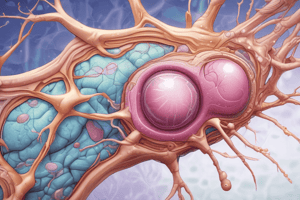Podcast
Questions and Answers
What type of gland are apocrine glands?
What type of gland are apocrine glands?
- They are small muscles causing goose bumps.
- They separate an epithelium from underlying tissue.
- They are major sweat glands found in all skin.
- They have a straight portion inserting into a hair follicle. (correct)
What are arrector pili?
What are arrector pili?
Small muscles which attach to hair follicles.
What is the basement membrane?
What is the basement membrane?
A thin, delicate membrane separating an epithelium from underlying tissue.
What are dermal papillae?
What are dermal papillae?
What is the dermis?
What is the dermis?
What are eccrine sweat glands?
What are eccrine sweat glands?
What is the epidermis?
What is the epidermis?
What is a hair follicle?
What is a hair follicle?
What is a freckle?
What is a freckle?
What does the hypodermis do?
What does the hypodermis do?
What is keratin?
What is keratin?
What is lanugo?
What is lanugo?
Who was Meissner?
Who was Meissner?
What is melanin?
What is melanin?
What are melanocytes?
What are melanocytes?
What are Pacinian corpuscles?
What are Pacinian corpuscles?
What is a papilla?
What is a papilla?
What is perspiration?
What is perspiration?
What is the pigment layer?
What is the pigment layer?
What is a pore?
What is a pore?
What is a sebaceous gland?
What is a sebaceous gland?
What is sebum?
What is sebum?
What does stratum refer to?
What does stratum refer to?
What is the stratum germinativum?
What is the stratum germinativum?
What does integument consist of?
What does integument consist of?
Flashcards are hidden until you start studying
Study Notes
Apocrine Sweat Gland
- Located at the junction of the dermis and subcutaneous fat
- Composed of a coiled secretory portion and a straight portion that secretes into hair follicles
Arrector Pili
- Small muscles attached to hair follicles in mammals
- Causes hair to stand on end, resulting in goose bumps when contracted
Basement Membrane
- A delicate membrane made of protein fibers and glycosaminoglycans
- Separates epithelial tissue from underlying tissue layers
Dermal Papilla
- Small, nipple-like extensions of the dermis into the epidermis
- Play a role in enhancing the exchange of nutrients and waste between the dermis and epidermis
Dermis
- The thick layer of skin beneath the epidermis
- Provides structural support, elasticity, and houses blood vessels, nerves, and glands
Eccrine Sweat Gland
- Major sweat glands found all over human skin
- Responsible for thermoregulation through sweat secretion
Epidermis
- The outermost layer of cells covering the skin
- Provides a barrier against environmental agents and contributes to the skin's appearance
Follicle
- A small secretory cavity or sac, particularly referring to hair follicles
- Essential for hair growth and development
Freckle
- Small patches of light brown color on the skin
- Become more pronounced with sun exposure and are genetic in nature
Hypodermis
- Layer of cells beneath the dermis in certain organisms
- Often associated with fat storage and insulation
Keratin
- A fibrous protein that forms the structural basis of hair, nails, and skin
- Provides strength and resilience to these structures
Lanugo
- Fine, soft hair that covers the body of a human fetus or newborn
- Often shed shortly after birth
Meissner's Corpuscles
- Specialized tactile receptors in the skin
- Sensitive to light touch and located in areas such as fingertips
Melanin
- A dark brown to black pigment present in hair, skin, and eyes
- Plays a crucial role in protecting skin from UV radiation
Melanocyte
- Melanin-producing cells typically found in the skin
- Responsible for skin pigmentation and protection against UV damage
Pacinian Corpuscles
- A type of mechanoreceptor found in the skin
- Sensitive to pressure and vibrations
Papilla
- A small rounded protuberance found on various parts of the body
- In the context of the skin, contributes to the structure of hair follicles
Perspiration
- The bodily process of sweating
- Essential for thermoregulation and waste removal
Pigment Layer
- The layer of the epidermis containing melanocytes
- Responsible for skin color and pigmentation patterns
Pore
- Tiny openings in the skin’s surface
- Allow for the passage of gases, liquids, and particles
Sebaceous Gland
- Small glands in the skin that secrete sebum
- Help to lubricate and moisturize the skin and hair follicles
Sebum
- Oily secretion produced by sebaceous glands
- Serves as a natural moisturizer for skin and hair
Stratum
- Refers to layers of material or social classifications
- In skin anatomy, indicates specific layers such as the stratum germinativum
Stratum Germinativum
- The innermost layer of the epidermis
- Responsible for generating new skin cells through division
Integument
- Comprises skin, mucous membranes, hair, and nails
- Acts as a protective barrier and sensory interface with the environment
Studying That Suits You
Use AI to generate personalized quizzes and flashcards to suit your learning preferences.




